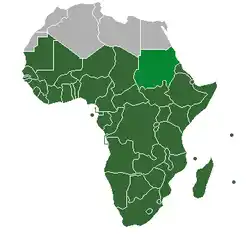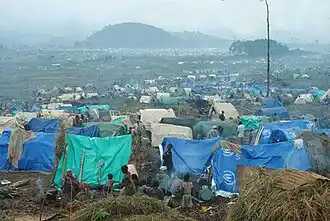
Sub-Saharan emigration to Europe refers to the historic process whereby people from countries south of the Sahara Desert in Africa have migrated to various parts of Europe, especially countries like Spain, France, Italy, Britain and Germany. This emigration started very gradually in the second half of the nineteenth century as European colonization of Africa, the so-called Scramble for Africa, intensified. It slowly grew in the twentieth century and expanded further in the aftermath of the Second World War as labor shortages in countries like France led to migration from places like Senegal to the colonial power being encouraged. However, it is really in the last fifty years that emigration has escalated considerably as travel from Sub-Saharan Africa to Europe has become easier via air and sea, while civil wars in the post-colonial era also drove migration away from places like the Congo. Climate change in the Sahel region, in particular, is fuelling Sub-Saharan emigration to Europe in modern times as former agricultural land is eroded owing to desertification and water shortages abound.[1]
Sub-Saharan emigration to Europe chronology of eventsSub-Saharan emigration to Europe chronology of events
Sub-Saharan emigration to Europe is a modern phenomenon. Prior to the sixteenth century contact between the two regions was almost non-existent and even thereafter it broadly consisted of points of contact with a specific number of coastal regions in western and southern Africa. It was only in the second half of the nineteenth century that Europeans began exploring and colonizing large parts of the continent, particularly in the interior. Thereafter a thin trickle of Sub-Saharan emigration began, often to cities like London, Paris and Brussels.[2]
This expanded in the middle of the twentieth century as a growing number of middle-class natives from Sub-Saharan colonies headed to the capitals of the colonial power to attend universities there or on other colonial business. Then, in the aftermath of the Second World War, as labor shortages abounded in countries like Britain, France and Germany, and as international travel over large distances became easier, more Sub-Saharan Africans began emigrating. The French, in particular, welcomed workers from former colonies like Senegal, Mali and the Ivory Coast as part of the Françafrique system of retaining ties between France and its many colonies in West Africa.[3]

In modern times Sub-Saharan emigration has been fuelled by war, conflict, economic crises and climate change. For instance, since the 1990s the region around the Congo Rainforest and the Great African Lakes has been plagued by terrible conflicts like the First and Second Congo Wars and the Rwandan genocide. The Horn of Africa has seen the long-running Ethiopian Civil War, clashes between Ethiopia and Eritrea, the Somali Civil War and the Isaaq genocide. These processes can reverse as well though. Today Ethiopia is just as likely to be a source of inward migration from other parts of Africa as outward migration to places like Europe.[4]
In West Africa the Liberian Civil War was one of the bloodiest in the region during the late twentieth century. More recently the Lake Chad Basin Crisis has fuelled emigration through a combination of climate change and desertification of the Sahel, the Boko Haram insurgency in north-eastern Nigeria, and general political and military instability in countries like Mali, Chad and Niger. All of this has fuelled emigration from Sub-Saharan Africa to Europe.[5]
Extent of Sub-Saharan emigration to EuropeExtent of Sub-Saharan emigration to Europe
The extent of Sub-Saharan emigration to Europe has varied from time to time and from place to place. There are many countries that very little emigration has taken place from. For instance, for a relatively large and well-populated country, very few Tanzanians have left their homeland for Europe over the last century. There are numerous factors involved in this, specifically the relative politically stability of the country since independence was achieved from Britain in 1961, as well as the geographical location of the country. Its remoteness from the Mediterranean Sea and Atlantic Ocean has meant that Tanzanians who have migrated over the decades have often done so to alternative locations like India, the Middle East, Australia or South Africa.[6]
The scale of Sub-Saharan emigration to Europe has been much greater in other cases. Colonial ties to Britain and France have facilitated this in many cases. For instance, tens of thousands of people have emigrated from Senegal to France over the last century. Senegal was France’s first colony in Africa. Similarly a lot of Malians and Cote D’Ivorians have moved from these former French colonies to France itself over the decades. Sizable numbers of Kenyans, Ugandans and others from former British colonies have immigrated to Britain.

The largest waves of Sub-Saharan emigration to Europe have occurred as a result of wars, conflicts and crises. As noted, the Congo Wars and the associated conflicts around the African Great Lakes since the 1990s have led to the emigration of hundreds of thousands of people from the Congo, Rwanda and Burundi. Many of these have immigrated to Europe. Thousands of Rwandan asylum seekers, for instance, emigrated from their homeland and found refuge in countries like Britain, France, Belgium and Germany following the Rwandan genocide in 1994 and the turmoil that continued there for years afterwards.[7]
Over the past decade or so climate change, political instability and war in the Sahel region is driving hundreds of thousands of people out of countries like Mali, Niger, Burkina Faso, Nigeria, Chad and Sudan. Many of these emigrants are making their way to the Maghreb and are then risking the Mediterranean passage to countries like Spain, Italy and Greece. It is difficult to assess the full extent of this emigration as many such migrants attempt to disguise their place of origin for various reasons connected to efforts to achieve asylum status, though clearly the number has become quite substantial since the mid-2010s.[8]
Demographic impact of Sub-Saharan emigration to EuropeDemographic impact of Sub-Saharan emigration to Europe
The demographic impact of Sub-Saharan emigration to Europe was limited and was controlled in times gone by. For instance, while there were several hundred thousand people from countries like Senegal, the Ivory Coast, Mali and Niger in France, much of this was welcomed as a means of tackling post-Second World War labor shortages. Similarly, relatively small but noticeable communities of Kenyans and Ugandans came to live in countries like Britain, while Belgium is host to a modest community of Congolese and Rwandan people.[9]

The demographic impact has started to shift in more modern times. Take the example of Sweden. This Scandinavian country took in a large number of Somali refugees beginning in the early 1990s as the multiple conflicts in the Horn of Africa intensified. Later these were joined by more emigrants and refugees from adjacent countries like Eritrea and Ethiopia which have also experienced decades of war, famine and civil war. As of 2022, there are nearly 70,000 Somalis, 50,000 Eritreans and 23,000 Ethiopians living in Sweden, a country of just around 10.5 million people in all. Thus, the demographic impact of this particular vein of Sub-Saharan emigration from the Horn of Africa to Sweden has been especially significant.[10]
In many other instances, the demographic impact is very hard to establish precisely. It is generally agreed that there are millions of Nigerians living in Europe today, and millions more that are second or third-generation Nigerians. Yet the exact figure is contested. Some studies argue that the number is a few million. Others contend that it runs to upwards of twenty million people. Illegal migration and a lack of proper documentation about where in Africa refugees and migrants have come from can create this lack of precision. The same is true where refugees have moved through several countries over the years before finally finding refuge in Europe. Their country of birth and country of origin can differ.[11]
See alsoSee also
Explore more about Sub-Saharan emigration to EuropeExplore more about Sub-Saharan emigration to Europe
- Climate-fueled Violence and Displacement in the Lake Chad Basin at Refugees International
- Democratic Republic of the Congo: A Migration History Marked by Crises and Restrictions at Migration Policy Institute
- Severe Repression in Eritrea Has Prompted Decades of Exodus at Migration Policy Institute
- Migration and Migrants: Regional Dimensions and Developments at UN Migration
- Once Primarily an Origin for Refugees, Ethiopia Experiences Evolving Migration Patterns at Migration Policy Institute
- Trans-Saharan Migration to North Africa and the EU: Historical Roots and Current Trends at Migration Policy Institute
- Understanding the patterns and causes of African migration at The Brookings Institute
References
- ↑ Hein de Haas, ‘The Myth of Invasion: The Inconvenient Realities of African Migration to Europe’, in Third World Quarterly, Vol. 29, No. 7, Globalisation and Migration: New Issues, New Politics? (2008), pp. 1305–1322.
- ↑ Thomas Pakenham, The Scramble for Africa (London, 1992).
- ↑ https://newafricanmagazine.com/16585/
- ↑ https://www.migrationpolicy.org/article/ethiopia-origin-refugees-evolving-migration
- ↑ https://www.migrationpolicy.org/article/ethiopia-origin-refugees-evolving-migration
- ↑ https://theconversation.com/tanzania-south-africa-deep-ties-evoke-africas-sacrifices-for-freedom-202448
- ↑ Muesiri Oberorakpovioma Ashe and Vivian Besem Ojong, ‘Population Overhang and the Great Lakes Crisis’, in Journal of African Union Studies, Vol. 7, No. 2 (August, 2018), pp. 127–147.
- ↑ https://www.globalr2p.org/countries/mali/
- ↑ https://www.refworld.org/reference/countryrep/unhcr/1998/en/94239
- ↑ https://www.refworld.org/reference/countryrep/unhcr/1998/en/94239
- ↑ https://trust-fund-for-africa.europa.eu/where-we-work/regions-countries/sahel-lake-chad/nigeria_en

